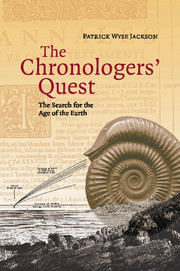Book contents
- Frontmatter
- Contents
- List of illustrations
- List of tables
- Preface
- Acknowledgements
- 1 The ancients: early chronologies
- 2 Biblical calculations
- 3 Models of Aristotelian infinity and sacred theories of the Earth
- 4 Falling stones, salty oceans, and evaporating waters: early empirical measurements of the age of the Earth
- 5 Thinking in layers: early ideas in stratigraphy
- 6 An infinite and cyclical Earth and religious orthodoxy
- 7 The cooling Earth
- 8 Stratigraphical laws, uniformitarianism and the development of the geological column
- 9 ‘Formed stones’ and their subsequent role in biostratigraphy and evolutionary theory
- 10 The hour-glass of accumulated or denuded sediments
- 11 Thermodynamics and the cooling Earth revisited
- 12 Oceanic salination reconsidered
- 13 Radioactivity: invisible geochronometers
- 14 The Universal problem and Duck Soup
- Bibliography
- Index
7 - The cooling Earth
Published online by Cambridge University Press: 02 December 2009
- Frontmatter
- Contents
- List of illustrations
- List of tables
- Preface
- Acknowledgements
- 1 The ancients: early chronologies
- 2 Biblical calculations
- 3 Models of Aristotelian infinity and sacred theories of the Earth
- 4 Falling stones, salty oceans, and evaporating waters: early empirical measurements of the age of the Earth
- 5 Thinking in layers: early ideas in stratigraphy
- 6 An infinite and cyclical Earth and religious orthodoxy
- 7 The cooling Earth
- 8 Stratigraphical laws, uniformitarianism and the development of the geological column
- 9 ‘Formed stones’ and their subsequent role in biostratigraphy and evolutionary theory
- 10 The hour-glass of accumulated or denuded sediments
- 11 Thermodynamics and the cooling Earth revisited
- 12 Oceanic salination reconsidered
- 13 Radioactivity: invisible geochronometers
- 14 The Universal problem and Duck Soup
- Bibliography
- Index
Summary
The twenty-first of September 1792 was a momentous day in Paris. King Louis XVI was deposed and the Republic was inaugurated. Four months later, on 21 January 1793, he lost his head on the Place de Louis Quinze (now the Place de la Concorde) to the newly introduced machine of death, the guillotine – first used in France in April 1792 – and at much the same time the trappings of royalty were dismantled. The royal garden in Paris, the Jardin du Roi, was renamed Jardin des Plantes. This garden was and remains one of the major botanic gardens of the world. It had been laid out in 1626 by Guy de la Brosse and Jean Héroard for Louis XIII, and specialised in medicinal plants – not unusual at the time, when plants were often used in traditional herbal medicine, and when the botanists and medics were always on the look out for new varieties and species which could provide different cures and remedies. The gardens, which now cover 28 hectares, were opened to the general public in 1650, and around them developed a number of institutions which now house the Muséum National d'Histoire Naturelle. Into this museum were brought numbers of exotic species of plants and animals, rocks and minerals collected from the far-flung corners of the French empire that stretched from the east to Louisiana in North America. Following the Revolution the King's own menagerie was removed from Versailles and the animals were transported to the site.
- Type
- Chapter
- Information
- The Chronologers' QuestThe Search for the Age of the Earth, pp. 105 - 118Publisher: Cambridge University PressPrint publication year: 2006



